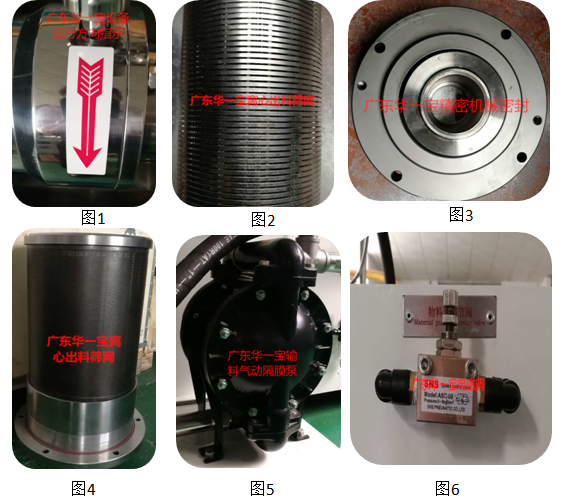
砂磨机的使用与维护
一、砂磨机试运行
(一) .砂磨机试运行前的准备工作:
1、检查各部件安装是否紧固;
2、电接点、感应点等配件的正确连接检查;(见图8/9)
3、设备运动方向应按箭头所指方向运转(以点动试确认);(见图1)
4、检查冷却水路渗漏、通畅情况;
5、机械密封冷却罐的冷却液添加;(见图10)
6、传动皮带调正适宜再启动,工作48小时后,再校正一次;
7、从厂家指定加珠口加入研磨介质;
8、先启动输料泵浦,输入物料,15秒内启动主机;(主机与泵有联锁装置,15秒不启动主机,送料泵自动停止)
(二).砂磨机试运行时的工作
1、较长时间停机后,再启动时,由于物料中的固体颗粒和研磨介质沉降而“抱”紧分散器,(见图11)尤其是粘稠性物料在较低温度时,“刹车”现象尤为严重。此时,点动电机不能启动时,在断电条件下,用手在主轴皮带轮助力转动,以输入少量对物料有溶解能力的稀释剂,使物料稀释松动后再启动。总之,不能强行启动,以免损坏电器和机体。
2、停机时间较长,保持管道与腔体内部处于真空状态(进、出料口都渗入液体内部的缸或罐中),并需清理筛网所堆积的物料。(见图2、4)
3、清洗分散器,只能轻微地、间歇性地转动,因为分散器和研磨介质在清洗液中快速运转极易损坏破碎(分散器一般都是高硬度材质)。
4、在使用(添加)新研磨介质时应进行过筛,以排除受磨后细小的研磨介质和其它杂物。
二、故障
1.送料泵不启动或工作中自停:
①:电源是否接通;
②:控制接触器回位检查;
③:电磁阀是否工作;(见图6)
④:模块是否松动。(见图12)
2.主机不能启动或工作中自停:
①:过流保护器是否熔断;
②:机封保护液面是否发生变化;(机封见图3,保护液见图10)
③:三角带是否太松;
④:分散器是否被卡住;
⑤:冷却水注入是否发生变化,引起超温。
3.电机负荷过大:
①:物料粘度是否过高;
②:研磨介质是否填充过量
③:电器线路是否正常;
④:输入物料速度是否过快,产生压力过高。
4.进料泵工作不正常:(见图5)
①:管道是否漏气,油水分离器的水份排泄;(见图7)
②:进料管是否堵塞
③:进料泵是否已严重磨损;
④:物料粘度是否过高。
5.生产效率下降:
①:研磨介质是否太少;
②:分散器是否已过度磨损;
③:前期分散时间是否改变;
④:原材料是否发生变化。

Use and maintenance of wet grinding machine
First, the trial run of the grinder
(1) Preparations for the grinding machine before commissioning:
1. Check whether the components are tightly installed;
2. Check the correct connection of electrical contacts, sensing points, etc. (see Figure 8/9)
3. The direction of movement of the equipment should be in the direction indicated by the arrow (confirmed by jog test); (see Figure 1)
4. Check the leakage and patency of the cooling waterway;
5. Add coolant to the mechanical seal cooling tank; (see Figure 10)
6. The transmission belt adjustment is suitable for restarting. After 48 hours of operation, it is corrected again.
7. Adding grinding media from the designated bead of the manufacturer;
8. Start the fuel pump first, input the material, start the host within 15 seconds; (the host and the pump have an interlock device, the host will not start for 15 seconds, the feed pump will stop automatically)
(2). Work when the grinder is in trial operation
1. After a long time of shutdown, when restarting, the solid particles and zirconia beads in the material settle and “carry” the disperser, (see Figure 11), especially when the viscous material is at a lower temperature, “brake The phenomenon is particularly serious. At this time, when the jog motor cannot be started, under the power-off condition, the hand pulley is assisted to rotate by hand to input a small amount of diluent which has the ability to dissolve the material, so that the material is diluted and then started. In short, you can't force it to start, so as not to damage the appliance and the body.
2. The downtime is long, and the inside of the pipeline and the cavity are kept in a vacuum state (the inlet and outlet ports are all infiltrated into the cylinder or tank inside the liquid), and the materials accumulated in the screen are cleaned. (See Figures 2 and 4)
3. The disperser is cleaned and can only be rotated slightly and intermittently, because the disperser and zirconia beads are easily damaged in the fast running in the cleaning solution (the dispersers are generally high hardness materials).
4. When using (adding) new grinding media, it should be sieved to remove fine zirconia beads and other debris after grinding.
Second, the fault
(1). The feed pump does not start or stops during work:
1: Whether the power is turned on;
2: Control contactor return check;
3: Whether the solenoid valve works; (see Figure 6)
4: Is the module loose? (See Figure 12)
(2). The host can't start or stop at work:
1: Whether the overcurrent protector is blown;
2: Whether the machine seal protects the liquid surface; (see Figure 3 for the machine seal and Figure 10 for the protective liquid)
3: Is the V-belt too loose?
4: Whether the disperser is stuck;
5: Whether the cooling water injection changes, causing over-temperature.
(3). Motor load is too large:
1: Whether the viscosity of the material is too high;
2: Whether the grinding media is overfilled
3: Is the electrical circuit normal?
4: If the input material speed is too fast, the pressure is too high.
(4). The feed pump is not working properly (see Figure 5)
1: Whether the pipeline leaks and the water in the oil-water separator is drained; (see Figure 7)
2: Whether the feed pipe is blocked
3: Whether the feed pump has been seriously worn;
4: Whether the viscosity of the material is too high.
(5). Reduced production efficiency:
1: Is the grinding medium too small;
2: Whether the disperser has been excessively worn;
3: Whether the pre-distribution time has changed;
4: Whether the raw materials have changed.